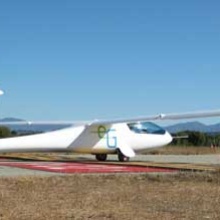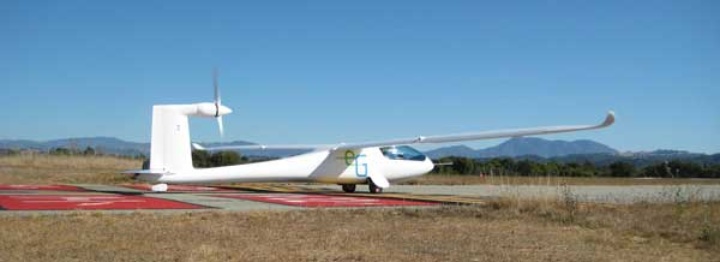Quick, efficient, and above all quiet: the electric aircraft e-Genius, which was developed at Institut für Flugzeugbau (IFB) of University of Stuttgart, won no fewer than two awards at the Green Flight Challenge 2011: at the competition organised by NASA and the Comparative Aircraft Flight Efficiency Foundation (CAFE), which took place from 25th September until 3rd October in Santa Rosa in California, the e-Genius-Team won the second prize in the overall standings endowed with 120,000 dollars as well as the Lindbergh prize endowed with 10,000 dollars for the quietest aircraft. The competition, which is about the construction of aircraft that are as environmentally friendly, practical and quiet as possible, is the highest endowed flight competition overall thanks to prize money from NASA in the amount of 1.65 million dollars in total.
Professor Rudolf Voit-Nitschmann, Managing Director of IFB, is delighted about the good
performance: „as one of the first electric aircraft, e-Genius is in a position in the first place
to provide comparable performances like conventional aircraft.“ In the Green Flight Challenge, the
battery-operated e-Genius competed against aircraft with diesel, biodiesel or hydrogen propulsion.
The most renowned opponent and overall winner was the team from the company Pipistrel, Slovenia,
with the Penn State University acting as their team leader. This team was awarded prize money of
1.35 million dollars. The main prize of the competition was awarded for efficiency and speed. In
spite of technical problems with the navigation device, e-Genius succeeded in achieving very good
results in the respective flights. This was made possible by a drive system the team developed
themselves, which has a performance of 60 kilowatt and an overall battery capacity of 56 kilowatt
per hour. The two-seater aircraft has a range of over 300 kilometres and thereby consumes when
converted less than one litre of petrol per 100 kilometres and passengers.
Definitely contributing towards the success was also the experience of the pilots: Eric
Raymond, who acted as the leader of the team, has been one of the leading solar flight pioneers for
many years; co-pilot Klaus Ohlmann is an experienced glider pilot and has set 48 world records in
his career – one of these with the solar flight icaré 2, a predecessor of the e-Genius.
The main competition was organised by CAFE Foundation on behalf of NASA, that set itself the task of contributing towards the progress of manned flights through research and training. In addition, there was another prize to be won: the Lindbergh Electric Aircraft Prize (LEAP) for the quietest Aircraft in the competition, which LEAP was awarding for the first time at the Green Flight Challenge. The award endowed with 10,000 dollars was presented by Erik Lindbergh, grandson of the aviation pioneer Charles Lindbergh. The Stuttgart aircraft secured the prize with volume levels in the range of only 56 to 62 decibel during take-off. As a comparison: a conventional turbine aircraft produces 16 times the volume level with around 100 decibels.
IFB has already been providing top performances with electrically operated aircraft for 17 years: since 1994 Rudolf Voit-Nitschmann and his employees have already been gathering experience in this field; it all started with the solar-operated motor glider project icaré 2. This project and also the successor Hydrogenius enabled the team of developers to win the prizes in 1996 and 2006 respectively at the international Berblinger Flight Competition from the city of Ulm. In the current project the team had numerous sponsors, including Airbus Deutschland and Stuttgart Airport.
Further information is available from Prof. Rudolf Voit-Nitschmann, Institut für Flugzeugbau
Tel. 0711/685-62770, email: RVN@ifb.uni-stuttgart.de, http://www.ifb.uni-stuttgart.de



